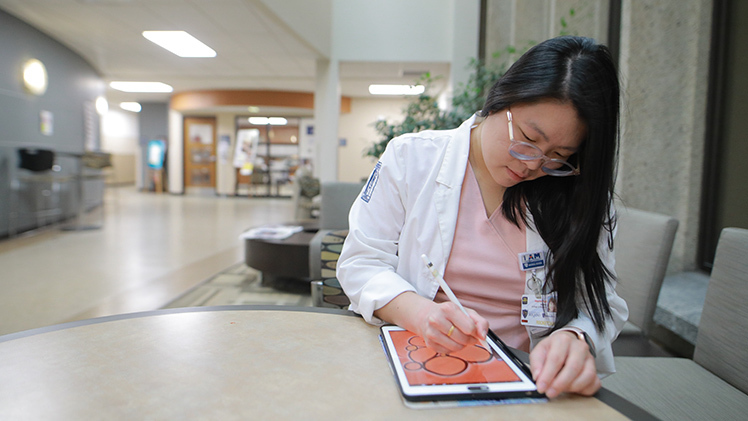Beauty, as they say, is in the eye of the beholder.
And so it was, quite literally, when Dr. Andrés Martin reached out to Nealie Ngo, a University of Toledo medical student and amateur illustrator of comics and graphic novels.

Nealie Ngo, a UToledo medical student and amateur illustrator of comics and graphic novels, works on an illustration for a Yale psychiatrist whose vision was temporarily affected by a detached retina, as part of a months-long project between the pair.
Martin, a psychiatrist and professor at the Yale School of Medicine, had just undergone surgery to fix a retinal detachment, and he had an unusual request for Ngo.
“As a natural side effect of the surgery, he saw these bubbles in his vision,” Ngo said. “They were both disorienting and confusing, but also curious and beautiful in their own way. He asked me if I could draw them for him.”
Ngo agreed, leading to a months-long project that sprouted a close friendship and, for Ngo, a deeper understanding of empathizing with people struggling with health issues.
The collaboration also resulted in a journal article. In September, Ngo and Martin published their story and her artwork in the journal Cureus as part of a special series of case reports in which physicians detailed stories from their own medical histories.
Retinal detachment is a rare but serious medical emergency. Without prompt treatment individuals can suffer permanent vision loss.
Martin’s eye was repaired successfully, but he was left to contend with both the memory of a frightening experience and the strange optical sensations that came with his recovery.
“I was seeing all these things right after my procedure and I had this need to share it, to make sense of it,” he said. “You can’t quite use words to do that.”
Though Ngo was a Yale alumna, she had only become acquainted with Martin through an academic conference they both attended after she had begun medical school at UToledo.
During their initial conversation about her interest in psychiatry, she’d shown Martin one of her comics.
“There was something in her art that just appealed to me,” Martin said. “I didn’t know her well as a person, but I knew enough to say this is a sensitive, special person who will get it.”
For more than six months, Martin and Ngo worked together to create visible representations of what otherwise existed only in his brain.

Nealie Ngo’s illustration of the bubbles that Dr. Andrés Martin was seeing following his surgery to fix a retinal detachment. For more than six months, the two worked together to create visible representations of what otherwise existed only in Martin’s brain.
Martin would send her annotated pencil sketches. Ngo would return digital images she drew on her iPad and then tweak them based on his response, almost like a police sketch artist working with a witness to get every detail correct.
“I was trying to capture what he was seeing in a way that felt real and authentic to him,” Ngo said. “He was describing them in these ways that seemed very ethereal, otherworldly in a sense.”
Over time, as things like color and texture got introduced, the pair began talking about other artists and inspirations. Sometimes they’d exchange dozens of messages a day.
Ngo ultimately drew nearly 20 panels, publishing the majority of them in the Cureus paper.
Not only did the project push Ngo as an artist — she had little experience in abstract illustration — but it also gave her an expanded appreciation of both how art can help provide autonomy to someone who is feeling helpless and its potential power as a complement to clinical medicine.
“The things that I love most about art are how it’s connected to people on an emotional level,” she said. “I think that’s something medicine can lack at some times. There’s so much memorization about pathology, but there’s not always enough emphasis on the humanism for medicine.”
The project also enabled Ngo to think about empathy in a way she hadn’t previously.
“Because we approach disease from such a clinical, objective and scientific way, it can be hard for me to truly feel like I can empathize with you or understand what you’re going through,” she said.
Listening to Martin describe in such detail both the mechanics of what happened and the fear and helplessness he felt made it much more personal than reading a textbook or reviewing case notes.
“As I go into practice, hopefully, I will continue to look back on this project and think more about it,” Ngo said. “It gave me an opportunity to empathize with people in a way that I’ve never been able to before and that’s something I’m really grateful for.”
For Martin, whose eye is now fully healed with no loss of vision, the process was equally valuable as a therapeutic outlet.
“The whole thing was such an unusual and frightening experience. I didn’t want to burden my wife, my family. They were burdened enough. I was just getting into these spirals of thinking that was not helpful,” he said. “Having this as an external thing, where I could talk about it, see it and see it as it evolved, was a very helpful experience.”
Following a gap-year to earn a master’s in public health from Columbia University in New York, Ngo is now in her fourth year of medical school. She’s currently in the process of interviewing for a psychiatry residency and hopes to continue being able to incorporate art into her practice.
Martin sees good things in her future.
“Nealie is extraordinary,” Martin said. “She’s become a good friend. She’s very talented and she’s very gifted, both in her heart and her thinking and her ability to use herself as an instrument of healing, which is what I like to think we do in psychiatry. I’m thrilled she’s coming into the same field.”